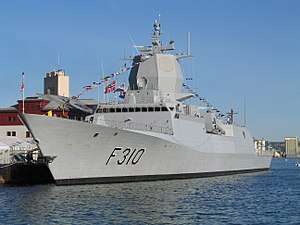Navantia
Navantia is a Spanish state-owned shipbuilding company, which offers its services to both military and civil sector. It is the fifth-largest shipbuilder in Europe, and the ninth-largest in the world with shipyards around the globe.
| State-owned enterprise | |
| Industry | Defence, Shipbuilding, Engineering |
| Predecessor | Empresa Nacional Bazán |
| Founded | January 1, 2005 |
| Headquarters | , |
Area served | Worldwide |
Key people | Susana Sarriá (Chairman and President) |
| Products | Warships, Hospital ship, Yachts, Ferries, Cargo ships, Platform supply vessels, Dredger, Marine propulsion, Offshore engineering |
| Revenue | |
| Owner | SEPI (100%) |
Number of employees | 5,500 (2015) |
| Subsidiaries | Navantia Australia Navantia Systems SAES Sainsel Sistemas Navales SA |
| Website | www.navantia.es |
Astilleros Españoles SA had been created in 1967 by merging of the shipyards of Euskalduna, La Naval de Sestao and Astilleros de Cádiz. In July 2000 it merged with the public naval shipyards, Empresa Nacional Bazán, to form IZAR.[2] In March 2005 Sociedad Estatal de Participaciones Industriales (SEPI) merged the naval wing of IZAR into Navantia.
Company
_01.jpg)

Navantia, the Spanish shipbuilder, 100% owned by SEPI, the Spanish government industrial holding, is engaged in the design, construction and integration of warships, as well as ship repairs & modernizations.
In March 2016 Navantia was selected as the "preferred bidder" to build two logistics support ships for the Royal Australian Navy.[3]
Major projects

- Carriers
- Príncipe de Asturias Harrier carrier (commissioned 1988)
- HTMS Chakri Naruebet (1997)
- Amphibious ships
- Juan Carlos I-class LHD and carrier (2010)
- Canberra-class LHD (2014)
- Galicia-class LPDs (1998, 2000)
- LCM-1E landing craft
- Supply ships
- Aegis Combat System | AEGIS Frigates
- F-100 Álvaro de Bazán-class frigate (2002–12)
- F-310 Fridtjof Nansen class (2006–11)
- Hobart-class destroyer (2016–19)
- Corvettes
- AEGIS corvette
- Multirole corvette
- Patrol ships
- BAM ocean patrol vessels (Spain, 2011–12)
- Guaiquerí-class patrol boat (Venezuela, 2011–12)
- Guaicamacuto-class patrol boat (Venezuela, 2010–11)
- Attack Patrol ships (44 m, 47 m, 63 m)
- Oceanic & Coast Patrol ships (79 m, 99 m)
- Mantilla-class patrol vessel (Argentina, 1982–83)
- Uribe-class patrol vessel (Mexico, 1982-83)
- Submarines
- Scorpène-class submarine - joint venture with DCNS for export
- Isaac Peral-class submarines (S-80A)
- Minehunter ships
- Oceanographic ships
- Combat and Control Systems
- Propulsion and energy generation systems
- Ship repair and conversions
See also
- Astilleros y Talleres del Noroeste
- Ferrol, Galicia
- Fene
References
- Infodefensa.com, Revista Defensa (2019-09-07). "Navantia incrementa sus ingresos un 21%, con la vista en Turquía e India - Noticias Infodefensa España". Infodefensa.com (in Spanish). Retrieved 2019-09-07.
- "ASTILLEROS ESPAÑOLES. 1969-2000". Archived from the original on 2015-11-15. Retrieved 2015-10-05.
- "Pre-election promise on shipbuilding sought by Labor, Xenophon, unions after Spain wins naval deal". ABC News. 11 March 2016. Retrieved 13 March 2016.
External links
| Wikimedia Commons has media related to Navantia. |